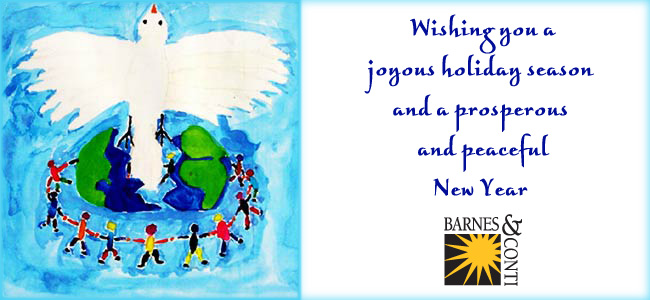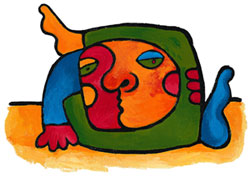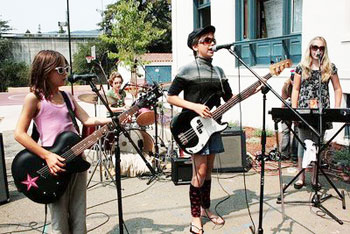

Leading the Way to a More Harmonious and Enjoyable Season
Eric L. Beckman, Barnes & Conti Vice President and CFO
The holiday season—with themes of light and hope and “peace on earth, goodwill towards men”— is meant to bring out the best in people. Unfortunately, the holidays also present many opportunities for stress, anxiety, and expectations which can grow into discomfort or explosive conflict. However, we each have a choice of how we will act and react to all the personalities and situations that arise; our choices can either help smooth or enflame the situation. If we exercise leadership, we can help ourselves and others move from conflict or potential conflicts towards a more enjoyable state.
Leadership is defined as the ability to lead or to provide guidance. More tangibly, it is getting others to follow you toward a goal (physical or metaphorical), helping people bring out the best in themselves, and deftly leading a group to success. Hundreds of books have been written on leadership, so I won't go into the whole subject here. I would like to offer some tips on leading your way to a more harmonious and enjoyable holiday season.
In any group or gathering, each person participating has a certain responsibility to the group—even though he/she may not be aware of it. Just as each of us has a responsibility to the society we choose to live in, we also have responsibilities to ourselves and the people with whom we share experiences. During the holidays, we choose to participate in social, cultural, and family gatherings where there are many different—and sometimes conflicting—expectations playing out simultaneously.
Before you gather with others for holiday get-togethers, see if you can answer the question: “What do I really want to happen?” Perhaps you are happy and excited to catch-up with family and friends, and would like to avoid any major issues. Maybe you want to get through the evening without listening to people argue about politics or religion. Perhaps you only want to figure out how to keep the kids away from that cussing, drunk relative you only see once a year...
Most conflicts, whether internal or external, begin as a set of expectations. They may be positive expectations that become unmet, or they may be negative expectations that we help make true. These skewed expectations can lead to disappointment, frustration, anger, sorrow, or open conflict. If conflict should arise, remember that we only control our own actions; we can't truly control anyone else.
Fortunately, most of us don’t have to deal with major drama. If you do see the potential for problems, you can make a choice ahead of time about how to deal with them and—if possible—get some agreements for help from others before you need it. One useful way to phrase your intentions is to use “Wouldn’t it be great if…” statements. Pick the most important or relevant of those, and then ask a few different “How can we…?” questions that help lead to your intended outcome. Ask these questions in a way that is optimistic, broadly inclusive, and considers the possible needs or desires of others who might be affected. You can even ask for some help and ideas from others to enlist additional support.
Choosing to lead has some real risks as well as rewards. If you suspect that there may be problems or issues that will surface, you should ask yourself what it will it cost you to ignore them. You could choose to attend a holiday gathering and make your presence as innocuous as possible. That doesn’t guarantee you won’t be seen as part of a problem if one arises. Remember, we are not only responsible for that which we do, but also that which we choose not to do.
You are a leader already. We all lead every day by the actions we take whenever we interact with others. Our impact on others may be unconscious, but it still has an effect. When we are upset, it upsets others. When we are happy and content, others are influenced positively. Try to remain consciously in the present so you can help others make the event an enjoyable and low-stress one to remember. The holidays are an opportunity to open yourself up to the goodwill most people are trying to spread and be part of.
In short, help yourself by helping others do the things that will make all of your holiday experiences go more smoothly with the following suggestions:
- Lead by example
- Set your expectations realistically
- Enlist others to help manage conversations
- Thank others openly for their thoughts and contributions
- Gently and privately remind people of any agreements made about behavior
- Remind yourself to have a good time, or at least the best time you can
Happy holidays to all!
Editor’s Note: Eric Beckmam is also one of our trainers and co-developer of our Conflict: From Prevention to Resolution program.
In This Issue:
Problem-Solving Program Successfully Piloted
Lessons on Giving from Scrooge, by Kim Barnes
Volunteerism and Community Service: Girls Rock Camp, by Jamie Freedman
New Technology Can Unlock the Gift of Creativity, by Carter Serrett
The Ninth Annual Barnes & Conti Virtual Feast
- Soup: Potato Leek (Lauren Powers)
- Salad: Pear, Gorgonzola, and Watercress (Kim Barnes & Don Bryant)
- Entrée: Wine Braised Beef Shank (Joel Kleinbaum)
- Libation: Eggnog (Eric Beckman)
- Dessert: Key Lime Pie (Elaine Turcotte)
- Wine Recommendations
Featured Art, Holiday Greeting: “Peace Dove” by Charlotte Albedron, Age 13
From the artist: “The painting is of a peace dove hatching out of the earth. Around the earth, people are dancing and everyone is from a different country but they are all rejoicing together.”
Featured Art, Virtual Feast (next page): “Christmas Dessert” by Kevin Turcotte (the artist is Elaine Turcotte’s brother)
 New Problem-Solving Program Successfully Piloted
New Problem-Solving Program Successfully Piloted
Our newest program, Puzzles, Mysteries, and Muddles: Taming the Wild Things that Keep You Up at Night, has been successfully piloted in the San Francisco Bay Area, New York City, and the Boston area, and to rave reviews. Puzzles, Mysteries, and Muddles presents a strategic approach to problem solving, with a focus on approaching the complex problems that organizations face today.
Program co-developer Jerry Talley, Ph.D., has developed a four-phase approach to problem solving, based on years of research and consulting. Two of the fundamentals of this approach are picking the right problem to solve, and properly “framing” the problem in order to find the right approach to solving the problem.
About those rave reviews, here's what attendees have said:
“I can’t remember a time when I left a session and I read the book again. I could not get enough of it.”
“This course will help me approach my problem from a different perspective— that’s the immediate benefit. More importantly, it’s provided a model that I can continue to use to approach my own problems, and that I can share with leaders and teams in supporting them to address their problems.”
More information on Puzzles, Mysteries, and Muddles
The Year 2009 in Review
2009 was a trying year for many if not most of us. The financial crisis created challenges for our colleagues, our customers and us. Fortunately, out of crisis comes opportunity, and we tried to make the most of it. We did less training, but more development. We found time to build current relationships and start new ones. We got creative about ways to reduce costs without reducing staff.
Highlights of the year included the development of our newest program, Puzzles, Mysteries, and Muddles: Taming the Wild Things that Keep You Up at Night together with Jerry Talley, Ph.D. This interesting and practical program has had an extraordinarily positive reception during pilots this summer and fall. For more about this unique problem-solving program, see the article above.
Our second newest program, Managing Innovation, first piloted in 2006, reached an important milestone. More than 2,000 people have attended the course! We would love to hear from the companies who are using and applying Managing Innovation and find out how the course has helped your organization to drive ideas from strategic initiative to value-creation. We hope to have some case studies available this winter or spring. Please note that—at the suggestion of a customer—we will be changing the subtitle of Managing Innovation to Driving Ideas from Strategic Initiative to Value Creation.
Our popular Exercising Influence program is now available in French, German, Chinese, Polish, Spanish, Thai, and Japanese, as well as American and British English. We had another first in Exercising Influence: the pre-course online assessment tool is now available in French as well as English.
Our Barnes & Conti global family expanded to Chile when CDO Consulting Group joined us as a global partner and Deconsulting became our partner in Mexico.
We have begun a relationship with Cornell University; we are co-developing and presenting a course for HR professionals on becoming a strategic business partner.
We were deeply saddened by the loss of our dear friend, Berta Berman. Many of us had been privileged to work with Berta for many years. Berta was a superb trainer, a generous colleague, and a wonderful friend. You can read our memorial tribute on the Barnes & Conti Blog. (Note: Donations in memory of Berta can be sent to Beit Yossi, 56/5 Rogozin st. Cluster D, Ashdod 77440, Israel.)
In addition to our blog, you can now follow Barnes & Conti on Twitter and on Facebook. The URLs are below:
- Twitter: http://twitter.com/BarnesConti
- Facebook http://www.facebook.com/pages/Barnes-Conti-Associates-Inc/72144622656
All in all, 2009 was an interesting year—we learned and grew. We wish you an interesting—and fortunate—2010.
Lessons on Giving from Scrooge
B. Kim Barnes, Barnes & Conti President & CEO
In my reading group—which met the other night—we had decided that for our holiday session, instead of reading and discussing a book, we would read Dickens’ A Christmas Carol aloud. Thanks to my good friend, John Porter, I found a condensed version written as a play with narration. After we had settled in with some holiday food and drink, we began.
I found myself volunteering to read the part of Scrooge, thinking we would pass the parts around at each “Stave” or section of the story. Somehow, though, the part remained mine through the entire story. By reading it aloud, I became more and more conscious of Dickens’ art in creating this character, a man who had been so damaged as a child and young man that he carried a burden throughout his life—until the visitations on Christmas Eve.
As you may recall, his late partner, Marley, appeared as a transparent ghost, wearing chains of greed and avarice, and of possession—cash-boxes, keys, padlocks, ledgers, deeds, and heavy purses. He suggested that Scrooge, in life, was equally weighted down. The story, as we all know, continues as Scrooge is visited by the ghosts of Christmases past, present, and future; as each ghost conducts him, he comes to see how much of life he has missed—and how little he himself will be missed by those who have had the displeasure of knowing him. He learns something about loss and about the paradox that the more you give away, the more you gain. As the story develops, you can see Scrooge becoming real and human—unlocking his chains and freeing himself to feel for and with others. With sly humor, Dickens reminds us of how joyful it feels to be alive and able to open our hearts to others:
I don’t know what to do. I am as light as a feather, I am as happy as an angel, I am as merry as a schoolboy. I am as giddy as a drunken man. A merry Christmas to everybody. A happy New Year to all the world. Hallo here. Whoop. Hallo.
Toward the end of the story, Dickens writes of Scrooge:
He became as good a friend, as good a master, and as good a man, as the good old city knew, or any other good old city, town, or borough, in the good old world. Some people laughed to see the alteration in him, but he let them laugh, and little heeded them; for he was wise enough to know that nothing ever happened on this globe, for good, at which some people did not have their fill of laughter in the outset; and knowing that such as these would be blind anyway, he thought it quite as well that they should wrinkle up their eyes in grins, as have the malady in less attractive forms. His own heart laughed: and that was quite enough for him.
And so, in this season of light, at the ending of a challenging year, I wish for all of us that we may become lighter ourselves through joyful giving; that we may know the exquisite pleasure of making others’ lives brighter and easier. Research has recenlty shown that we become happier when we give something to others than when we receive something for ourselves. Charles Dickens had that figured out—as have many of the great religious leaders over the millennia —and as we know in our own hearts today. Let it be said of us, as it was of Scrooge, that we know how to keep Christmas (or the other holidays of this season) well.
 Volunteerism and Community Service: Girls Rock Camp
Volunteerism and Community Service: Girls Rock Camp
Jamie Freedman, Project Coordinator
Editor's Note: Barnes & Conti's commitment to our communities is often reflected in the volunteer and community service work our people do. Jamie Freedman has a passion for music. Not only that, but she is a Bay Area correspondent in music for examiner.com. We hope Jamie's story of service and volunteerism inspires you.
Since the summer of 2006, I have been an active volunteer for Girls Rock Camp. I first got in involved with Rock Camp after graduate school in Austin, Texas and continued my participation when I moved to the Bay Area in 2007.
Girls Rock Camp began in 2001, emerging out of the 1990s Riot Grrrl, a feminist movement rooted in punk music. In the last eight years, camps have sprung up all over the United States and even internationally. The purpose of Rock Camp is to empower girls between the ages of 8-18 to have confidence and to express themselves using the medium of rock music. In a five-day summer camp, girls learn an instrument, form a band, write a song and perform it on stage. The camps are mostly volunteer-run and many of the girls enrolled in camp receive partial—if not a full scholarship.
The first year I volunteered for Girls Rock Camp I coached a band of 8 to 10-year-old girls. I helped them write two songs, one about a ghost named “Bloody Mary” and another about an ice cream stomach ache (age appropriate for nine-year olds). When I heard the songs performed live, I cried and laughed and cried. I was totally hooked.
I was part of the inaugural camp sessions of both the Austin (2006) and Bay Area Girls Rock Camps (2007). I coached bands—helping them to write the songs they will perform at the end of the week—as well as lead workshops on The History of Women Who Rock.
I’m also on the camp’s Advisory Board. This past December 4th, Girls Rock Camp held a silent auction fundraiser where more than 70 items were donated, including private lessons with me! I will also be volunteering for the after school program starting in 2010 by teaching workshops in digital media and women who rock.
At the fundraiser, the Rock Camp alumni band, Poison Apple Pie, played. All three girls are 12 years old. They play covers and write their own songs. The drummer and the bassist/lead vocalist were campers in the band I coached two summers ago (see the photo, above). The drummer is now my private student, although we play piano, guitar, sing and study music theory.
It is no secret that many of the volunteers live vicariously through their campers wishing they had Rock Camp when they were kids. That's why the three-day-weekend Ladies Rock Camp was created for women ages 19 and up. Last year I signed up and learned to play the bass guitar; my band was called “Mama and the Tweets.” I’m hoping to get my mom and Kim Barnes to sign up for next years Ladies Rock Camp. Kim says she would want to play the drums. I’m going to hold her to it!
To find a Rock Camp near you: Girls Rock Camp Alliance
More info on the Bay Area Girls Rock Camp
More Barnes & Conti Volunteerism/Community Service
Barnes & Conti’s innovative community service policy allows each employee to be compensated for one day of community service per quarter. Some of the highlights of our holiday activities are:
- Elaine Turcotte, Client Services Director, hosted and cooked for a community Thanksgiving outreach.The dinner was co-sponsored by San Francisco’s Temple United Methodist Church and Gum Moon (an agency of the UMC). Over 200 people, mostly Chinese, attended. Elaine said that for most of them, it was their first American Thanksgiving ever.
- Lauren Powers, Eastern Regional Director, will be spending the holidays in New Orleans. She and her family are going to help rebuild the city as part of the St. Bernard’s project. Lauren’s daughter, Emma, has also caught the spirit of volunteerism, and has been volunteering for Hearts of Gold, an organization that works with homeless mothers and children in New York City.
- Joel Kleinbaum, IS Manager and Newsletter Editor, has found ways of using his music to serve the community. This past April, he played a bassoon recital/demonstration at a day shelter for children of homeless families. The shelter is run by Human Solutions. During the holiday season, he has been playing his bassoon at other community outreach events via the newly formed Harrison Hill Chamber Players in Portland, Oregon.
 New Technology Can Unlock the Gift of Creativity
New Technology Can Unlock the Gift of Creativity
Carter Serrett, Vice President of Sales & Marketing
“Behind every tortured soul is a frustrated artist.”
This has been said before and—since I can’t locate the original source—my mother gets the credit. It seems I have spent much of my life writing novels in my head and painting great works of art with my mind. With the “mind's eye” we can create breathtaking landscapes with perfect colors, metaphors and imagery. Yet, in taking pen to paper or brush to canvas what comes out is light years away from the brilliance we created between our ears.
Life has a funny way of sneaking up on many; Art had a funny way of sneaking up on me. Art sneaked up, grabbed me, and said, “gotcha!” all by way of my iPhone! That little piece of “gotta have it” technology finally found the artist in me, After 40 years of saying, “I’m not creative—I can’t even draw a straight line,” I now find myself not turning on my TV for days to pursue creating “Art” on that little bugger.
As silly as it may seem, I learned that technology can play a key role in unlocking the creativity in some people; it was all about finding the right tools. Joni Mitchell said:
At the point where I’m trying to force something and it’s not happening, and I’m getting frustrated with, say, writing a poem, I can go and pick up the brushes and start painting. At the point where the painting seems to not be going anywhere, I go and pick up the guitar.
There are countless children across the world who strum a guitar and find it doesn’t sing to them; they pick up a paintbrush and find it doesn’t flow the way they want it to. They end up walking away from art and creativity frustrated and confused. I found that technology allowed me to find my inner artist; perhaps one of you will find a way to use technology to unlock the creative voice within.
With the intent of beating Kim Barnes to a new and innovative application, I decided some months ago to explore and experiment with as many new “apps” as I could cram into the phone. I ended up with a whole collection of image-editing tools. Some have you begin with an image and lets you blend in other images. You can change colors, shade and shadow portions of it, make patterns, and more. When you're done you crop and frame. I could—and did—spend 7 and 8 hours at a time sitting on my living room floor working on an image that perhaps only I could enjoy.
As odd is it seems, the iPhone has changed my life. I can now take at look at myself, and perhaps remove that label that says “not creative.”
Editor's note: Carter submitted several pieces of his art. We selected the flying berry pies to introduce our virtual feast. You can see more of Carter’s art on Flickr.
The Newsletter Continues with Our Virtual Feast...